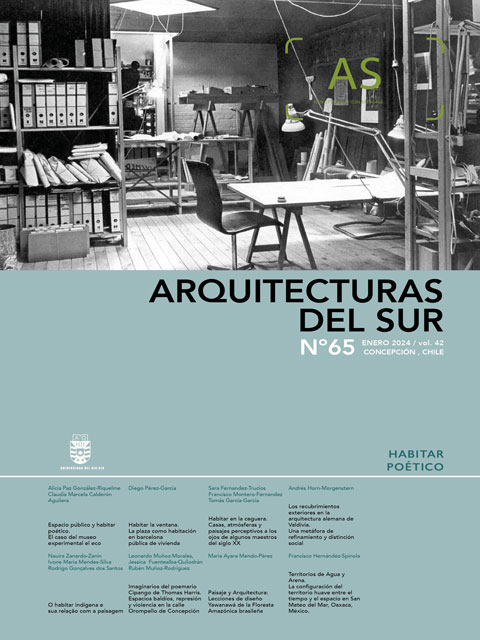Landscape and Architecture: Yawanawá Design Lessons from the Brazilian Amazon Forest
DOI:
https://doi.org/10.22320/07196466.2024.42.065.07Keywords:
indigenous architecture, architectural design, landscape design, historical heritage, indigenous peopleAbstract
The purpose of this article is to observe the spatial design practices of the Yawanawá indigenous population that inhabits the Rio Gregorio Indigenous Land, located in the Brazilian Amazon Forest. In collaboration with this community, the intention is to reflect on approaches that can enrich the research of their spatial knowledge, thereby contributing to the consolidation of Amerindian knowledge in the academic field of architecture and design. The participant observation methodology allowed an immersion into Yawanawá narratives that rescue their ancestral role in the architectural and landscape configuration of the territory. Through elaborating a photographic visual investigation, it is sought to expand voices and meanings in strata of coexisting times, articulating the images to the Amerindian architectural conceptions that survived colonial abuse. In the conclusions, the lessons that the Yawanawá express and manifest are highlighted when building spaces of resistance in a poetic, symbolic, and daily way where the urban power structures constructed and/or that cross their territory were and are re-signified to test other ways of living in the forest.
Downloads
References
AQUINO, T. e IGLESIAS, M. (1994) Kaxinawá do Rio Jordão: história, território, economia e desenvolvimento sustentável. Rio Branco, Kenê Hiwê/Comissão Pró-Índio do Acre, COICA. OXFAM. https://acervo.socioambiental.org/acervo/documentos/kaxinawa-do-rio-jordao-historia-territorio-economia-e-desenvolvimento-sustentado
BACHELARD, G. (1957) La Poética del Espacio. (4 ª ed., 2000) Brevario. Fondo Cultura Económica, FCE.
BALÉE, W. (2006). The research program os historical ecology. Annual Review of Anthropology, 35.75-98. https://www.lakeheadu.ca/sites/default/files/uploads/53/outlines/2014-15/NECU5311/Balee_2006_AnnRevAnth_HistoricalEcology.pdf
BALÉE, W. (2008). Sobre a indigeneidade das Paisagens. Revista de Arqueologia, 21(2), 9-23. https://doi.org/10.24885/sab.v21i2.248
BANIWA, D. (2021). Ficções coloniais. Revista Zum, (20), 1-184. Instituto Moreira Salles. https://lojadoims.com.br/product/38192/zum-20
BRENNER, N. y SCHMID, C. (2012) Planetary Urbanization. https://www.academia.edu/37576946/Neil_Brenner_and_Christian_Schmid_Planetary_urbanization_in_Matthew_Gandy_ed_Urban_Constellations_Berlin_Jovis_2012_10_13
CAMARGO-TAVARES, L. (2013). Fonologia, morfologia e sintaxe das expressões nominais
em Yawanawá (pano) [Dissertação de Mestrado apresentada ao Programa de Pós-Graduação em Linguística]. Universidade Federal do Río de Janeiro. https://amerindias.github.io/referencias/sou13yawanawa.pdf
CANÇADO, W., MOULIN, G., MÁRQUEZ, R. y ANDRÉS, R. (2022). Habitar o Antropoceno. BDMG.
CARID NAVEIRA, M. A. (1999). Yawanawá: da guerra à festa. Dissertação. [Tesis Mestrado em Antropologia Social]. Universidade Federal de Santa Cantarina, Florianópolis https://repositorio.ufsc.br/bitstream/handle/123456789/80847/151413.pdf?sequence=1
CRUMLEY, C. L. (2007). Historical ecology: Integrated thinking at multiple temporal and spatial scales. https://www.researchgate.net/publication/40010750_The_World_System_and_the_Earth_System_Global_Socioenvironmental_Change_and_Sustainability_Since_the_Neolithic
CUNHA, M. C. (2023). Anti-domesticação. PISEAGRAMA. Vegetalidades
DANOWSKI, D. y VIVEIROS DE CASTRO, E. (2017). Há um mundo por vir? Ensaio sobre os medos e os fins. Futuros Póximos. Instituto Socioambiental.
HECKENBERGER, M., PETERSEN, J. y NEVES, E. (1999). “Village Size and Permanence in Amazonia: Two Archaeological Examples from Brazil”. Latin American Antiquity. (4)10. 353-376. https://www.researchgate.net/publication/248329217_Village_Size_and_Permanence_in_Amazonia_Two_Archaeological_Examples_from_Brazil
HECKENBERGER, M., RUSSELL, C., FAUSTO, C., TONEY, J. R., SCHMIDT, M. J., PEREIRA, E., FRANCHETTO, B. y KUIKURO, A. (2008). Pre-Columbian urbanism, anthropogenic landscapes and the future of the Amazon. Science, 321(5893). 1214-1217. https://doi.org/10.1126/science.1159769
HEIDEGGER, M. (1951) Construir, habitar, pensar. Oficina de Arte y Ediciones.
Sistema de información de Salud Indigena, Siasi/Sesai, (2014). Terra Indígena Rio Gregório Área habitada por Katukina Pano e Yawanawá. https://terrasindigenas.org.br/pt-br/terras-indigenas/3846
Instituto Brasileiro de Geografía e Estatística, IBGE. (2002). Territorio brasileiro e povoamente. Historia indígena. Tierras Indígenas. https://brasil500anos.ibge.gov.br/territorio-brasileiro-e-povoamento/historia-indigena/terras-indigenas.html
JECUPÉ, K. W. (1998). A Terra dos mil povos: história indígena do Brasil contada por um índio. Peirópolis.
KRENAK, A. (2022). Saiam desse pesadelo de concreto!. En : Habitar o Antropoceno. BDMG Cultutal.
KRENAK, A. (2023). Futuro Ancestral. Companhia das Letras.
LEFEBVRE, H. (1970) . A revolução urbana. Editora UFGM.
MENDO PÉREZ, M. A. (2018). Tudo o que era ar se desmancha no capital: formas de urbanização extensiva na Terra Indígena Rio Gregório do estado do Acre. [Tesis de Doutorado]. Universidade Federal do Rio de Janeiro. http://objdig.ufrj.br/42/teses/869355.pdf
MENDO PÉREZ, M. A. (2022). Entre a dança e a arquitetura das mulheres Yawanawá: práticas espaciais indígenas na contemporaneidade. PosFAUUSP, 29(54), https://doi.org/10.11606/issn.2317-2762.posfauusp.2022.176960
ONU (2021). State of the World’s Indigenous Peoples: Rights to Lands, Territories and
Povos Indigenas no Brasil. (2023). Quem são?. https://pib.socioambiental.org/pt/Quem_s%C3%A3o
RIBEIRO, L. (2005). Metrópoles. Entre a coesão e a fragmentação, a cooperação e o conflito. Revista eure, (31)939, 104-107. https://www.scielo.cl/scielo.php?script=sci_arttext&pid=S0250-71612005009300008
SCHLEE, R. A. (2012). A contribuição dos arquitetos para o estudo da morada indígena. Ciência & Ambiente, 45. 78,90.
VINNYA, A. L., PINEDO, M. L. y TEIXEIRA, G. (2007). Costumes e Tradições do Povo Yawanawá. Organização dos Professores Indígenas do Acre. https://cpiacre.org.br/wp-content/uploads/2020/03/Costumes-e-Tradicoes-do-Povo-Yawanawa.pdf
XAKRIABÁ, C. (2020). Amansar o giz. PISEAGRAMA.14. 110-117. https://piseagrama.org/amansar-o-giz/
YAWANAWÁ, P. (19 de abril de 2017). Plano de vida Yawanawá. Portal Tarauacá. https://estadodoacre.com.br/2017/04/tarauaca-plano-de-vida-yawanawa/
Downloads
Published
How to Cite
Issue
Section
License
Copyright (c) 2024 Maria Ayara Mendo-Pérez

This work is licensed under a Creative Commons Attribution-ShareAlike 4.0 International License.
The content of the articles published in each issue of Arquitecturas del Sur is the sole responsibility of the authors and does not necessarily represent the opinion of University of the Bío-Bío.
The authors will maintain their copyright; however, they will guarantee the journal the right to first publication and dissemination of their work. The publication of the article in Arquitecturas del Sur will be subject to the Creative Commons International license (CC BY-SA) that allows others to adapt: remix, transform and build on the material for any purpose, even commercially; share: copy and redistribute the material in any medium or format, as long as the authorship and first publication in this journal are acknowledged by citing them correctly, and their new contributions are under a license with the same terms.














 Programa de Información Científica/Concurso Fondos de Publicación de Revistas Científicas 2018/ Proyecto Mejoramiento de Visibilidad de Revistas UBB (Código:FP180007)
Programa de Información Científica/Concurso Fondos de Publicación de Revistas Científicas 2018/ Proyecto Mejoramiento de Visibilidad de Revistas UBB (Código:FP180007) 
